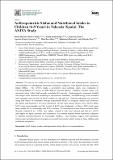Por favor, use este identificador para citar o enlazar a este item:
http://hdl.handle.net/10261/140856COMPARTIR / EXPORTAR:
 SHARE SHARE
 CORE
BASE CORE
BASE
|
|
| Visualizar otros formatos: MARC | Dublin Core | RDF | ORE | MODS | METS | DIDL | DATACITE | |

| Título: | Anthropometric status and nutritional intake in children (6-9 years) in Valencia (Spain): The ANIVA study |
Autor: | Morales-Suárez-Varela, M.; Rubio-López, N.; Ruso, C.; Llopis-Gonzalez, A.; Ruiz-Rojo, E.; Redondo, M.; Picó, Yolanda CSIC ORCID | Palabras clave: | Dietary intake Child Dietary recommendations Anthropometric status |
Fecha de publicación: | 18-dic-2015 | Editor: | Molecular Diversity Preservation International | Citación: | International Journal of Environmental Research and Public Health 12(12): 16081-16095 (2015) | Resumen: | The aim of our study was to assess nutritional intake and anthropometric statuses in schoolchildren to subsequently determine nutritional adequacy with Spanish Dietary Reference Intake (DRIs). The ANIVA study, a descriptive cross-sectional study, was conducted in 710 schoolchildren (6-9 years) in 2013-2014 in Valencia (Spain). Children’s dietary intake was measured using 3-day food records, completed by parents. Anthropometric measures (weight and height) were measured according to international standards, and BMI-for-age was calculated and converted into z-scores by WHO-Anthro for age and sex. Nutrient adequacy was assessed using DRI based on estimated average requirement (EAR) or adequate intake (AI). Pearson’s chi-square and Student’s t-test were employed. Of our study group (47.61% boys, 52.39% girls), 53.1% were normoweight and the weight of 46.9% was inadequate; of these, 38.6% had excess body weight (19.6% overweight and 19.0% obesity). We found intakes were lower for biotin, fiber, fluoride, vitamin D (p < 0.016), zinc, iodine, vitamin E, folic acid, calcium and iron (p < 0.017), and higher for lipids, proteins and cholesterol. Our results identify better nutritional adequacy to Spanish recommendations in overweight children. Our findings suggest that nutritional intervention and educational strategies are needed to promote healthy eating in these children and nutritional adequacies. | Versión del editor: | https://doi.org/10.3390/ijerph121215045 | URI: | http://hdl.handle.net/10261/140856 | DOI: | 10.3390/ijerph121215045 | Identificadores: | issn: 1660-4601 |
| Aparece en las colecciones: | (CIDE) Artículos |
Ficheros en este ítem:
| Fichero | Descripción | Tamaño | Formato | |
|---|---|---|---|---|
| Anthropometric Status_Pico.pdf | 237,76 kB | Adobe PDF |  Visualizar/Abrir |
CORE Recommender
PubMed Central
Citations
10
checked on 15-abr-2024
SCOPUSTM
Citations
17
checked on 21-abr-2024
WEB OF SCIENCETM
Citations
15
checked on 25-feb-2024
Page view(s)
156
checked on 22-abr-2024
Download(s)
228
checked on 22-abr-2024

